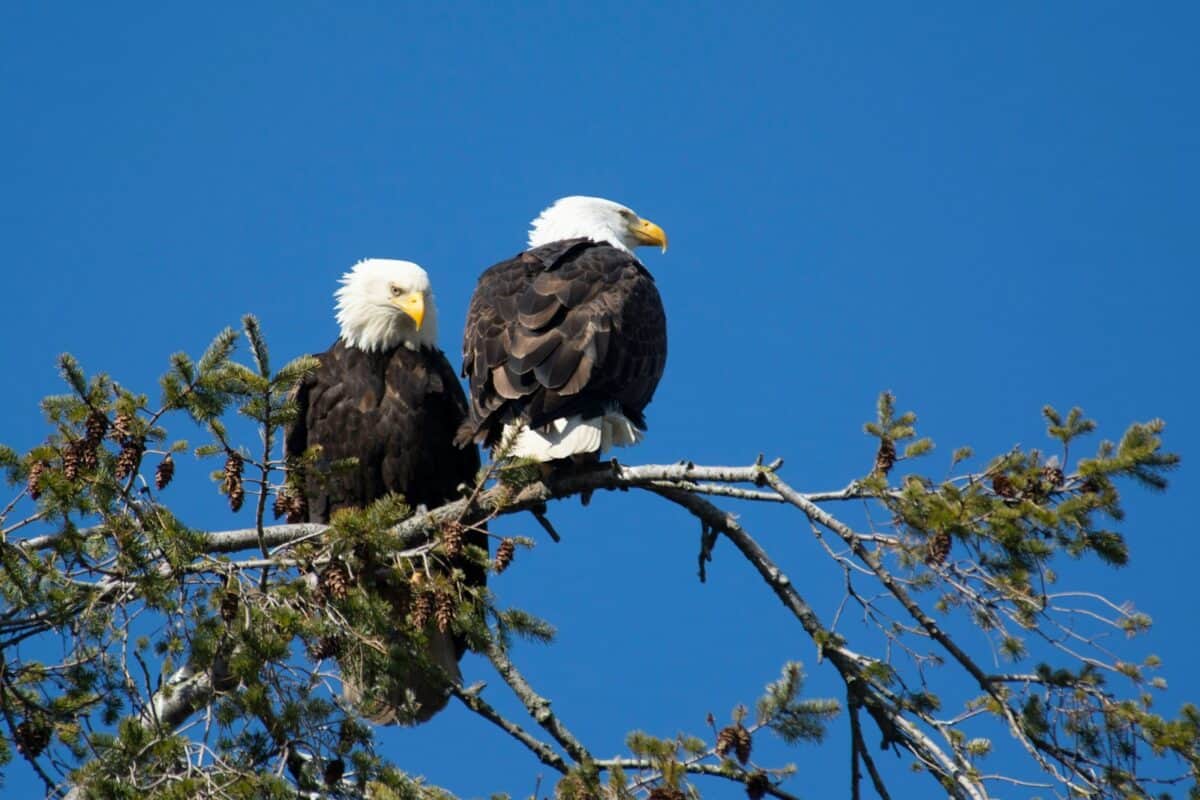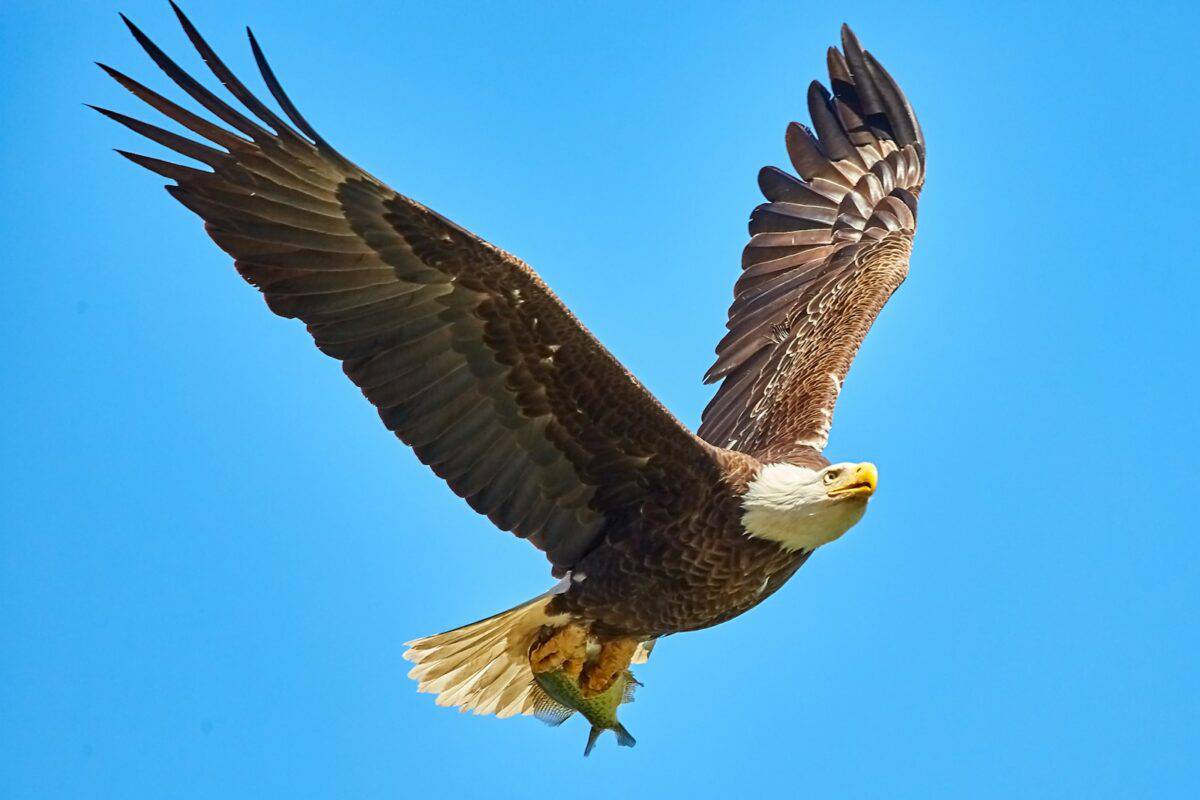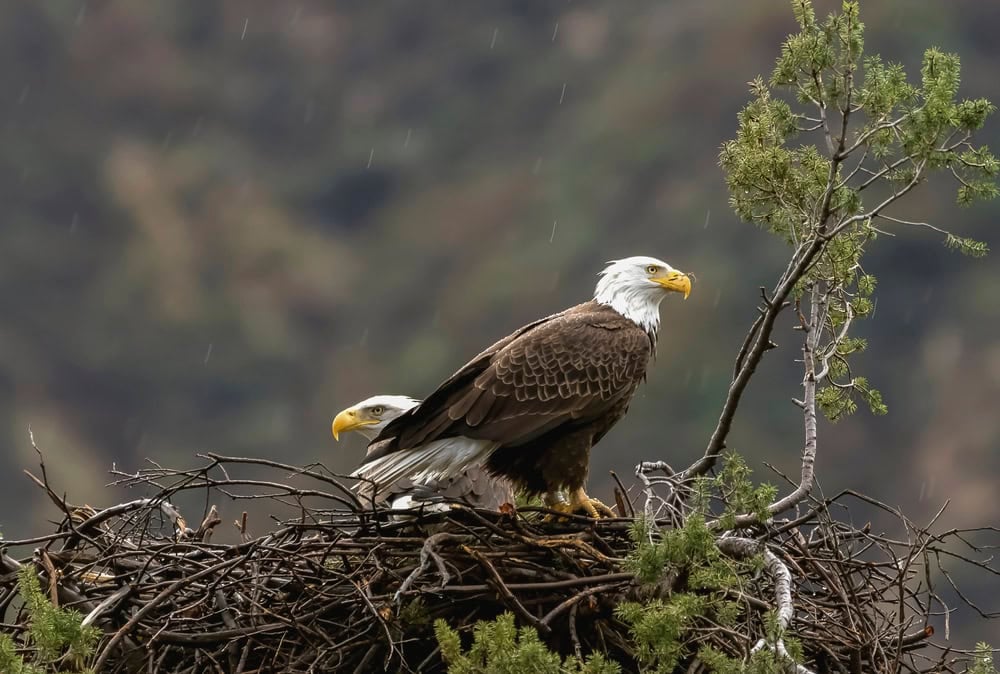The bald eagle, America’s national bird and symbol of freedom, once faced near extinction due to hunting, habitat loss, and the devastating effects of DDT pesticides. Thanks to conservation efforts and protective legislation like the Endangered Species Act of 1973, these majestic birds have made a remarkable comeback. Today, wildlife enthusiasts can spot bald eagles across numerous states, particularly during their breeding seasons and winter migrations. With their distinctive white heads, chocolate-brown bodies, and impressive seven-foot wingspans, these magnificent raptors offer an awe-inspiring sight in the wild. This guide explores 17 states where your chances of witnessing these iconic birds in their natural habitat are highest.
Alaska Eagle Capital of America

Alaska rightfully earns its reputation as the bald eagle capital of the United States, hosting approximately 30,000 bald eagles—roughly half of the entire North American population. The Chilkat Bald Eagle Preserve near Haines offers an unparalleled viewing experience, particularly during the late fall salmon runs when hundreds of eagles gather along the river. The abundant food supply and vast stretches of undeveloped coastline make Alaska an ideal habitat for these birds year-round. In particular, the Inside Passage region and Kodiak Island provide exceptional opportunities for eagle spotting, with some locations featuring dozens of eagles visible at once during peak seasons.
Minnesota Land of 10,000 Lakes and Eagles

Minnesota’s landscape of numerous lakes, rivers, and forests creates perfect bald eagle habitat across the state. The Mississippi River corridor hosts one of the highest concentrations of nesting bald eagles in the lower 48 states, particularly near the Twin Cities. Wabasha’s National Eagle Center offers educational programs and reliable eagle viewing opportunities year-round. During winter months, open water areas below dams become crucial feeding grounds where eagles congregate in impressive numbers. Minnesota currently supports over 1,300 active eagle nests, representing an extraordinary recovery since the 1970s when fewer than 200 nests existed statewide.
Florida Year-Round Eagle Haven

Florida boasts the largest bald eagle population in the contiguous United States, with over 1,500 nesting pairs recorded in recent surveys. Unlike northern states, Florida’s eagles don’t typically migrate, remaining year-round residents thanks to the state’s favorable climate and abundant food sources. Prime viewing locations include the Kennedy Space Center, Honeymoon Island State Park, and numerous lakes throughout central Florida. The nesting season runs from October through May, offering extended opportunities to observe breeding behaviors and eaglets. The state’s eagles build some of the largest nests in the nation, with some structures weighing up to a ton after years of additions.
Washington Pacific Northwest Paradise

Washington state provides essential habitat for approximately 1,300 breeding pairs of bald eagles, particularly along its coastal areas and major waterways. Skagit River Eagle Festival celebrates the annual winter congregation of hundreds of eagles feeding on salmon, offering guided tours and viewing platforms. The San Juan Islands and Puget Sound region support dense eagle populations viewable year-round. Olympic National Park’s coastline and Lake Crescent provide excellent viewing opportunities as eagles hunt among the old-growth forests and along pristine shorelines. Washington’s eagles benefit from the state’s robust salmon runs, allowing for spectacular feeding displays during spawning seasons.
Wisconsin Upper Midwest Eagle Country

Wisconsin features approximately 1,700 bald eagle nests, with populations concentrated along the Mississippi River, Wisconsin River, and numerous inland lakes. During winter, the open waters below dams become critical feeding areas where dozens of eagles may gather in a single location. The Sauk Prairie area hosts Eagle Days each January, celebrating the winter congregation of eagles along the Wisconsin River. Prairie du Sac Dam is particularly notable for winter eagle viewing, where unfrozen waters provide essential fishing opportunities during harsh winter months. Wisconsin’s eagles begin nesting activities as early as February, with pairs often returning to the same massive nests for multiple years.
Maine Northeastern Eagle Stronghold

Maine hosts the largest bald eagle population in the northeastern United States, with over 700 nesting pairs documented in recent surveys. The state’s extensive coastline, numerous islands, and inland lakes provide diverse eagle habitat. Cobscook Bay and Merrymeeting Bay are particularly renowned for their high eagle concentrations, supporting dozens of nesting pairs within relatively small areas. Maine’s eagles often remain year-round if sufficient open water exists for hunting, though some migrate slightly southward during the harshest winter periods. Conservation efforts have been remarkably successful in Maine, where eagle populations have increased twentyfold since the 1970s when fewer than 30 breeding pairs remained statewide.
Maryland Chesapeake Bay Eagle Haven

Maryland’s portion of the Chesapeake Bay watershed provides critical habitat for several hundred nesting pairs of bald eagles. Blackwater National Wildlife Refuge on the Eastern Shore boasts one of the densest eagle populations on the Atlantic coast, with dozens of active nests within the refuge boundaries. Conowingo Dam on the Susquehanna River attracts hundreds of eagles during winter months when they feed on fish disoriented by the dam’s turbines. Maryland’s eagles benefit from the Chesapeake Bay’s productive ecosystem, which supplies abundant fish and waterfowl prey. The state’s eagle population has recovered dramatically from just 41 breeding pairs in 1977 to over 600 pairs today, representing one of conservation’s great success stories.
Michigan Great Lakes Eagle Territory

Michigan’s extensive shorelines along four Great Lakes and its thousands of inland lakes and rivers support a thriving bald eagle population of approximately 800 breeding pairs. The Les Cheneaux Islands region in the eastern Upper Peninsula hosts one of the highest concentrations of nesting eagles in the state. During winter, partially frozen rivers like the Au Sable and Manistee attract eagles that hunt in the remaining open waters. The Seney National Wildlife Refuge provides protected nesting habitat for dozens of eagle pairs in Michigan’s Upper Peninsula. Michigan’s eagle population has steadily increased since the 1970s when fewer than 100 breeding pairs remained, demonstrating the effectiveness of clean water initiatives and habitat protection measures.
Oregon Pacific Coast Populations

Oregon supports approximately 700 breeding pairs of bald eagles, with concentrations along the Columbia River, coastal estuaries, and the Klamath Basin. Upper Klamath Lake and the surrounding national wildlife refuges host one of the largest winter gatherings of bald eagles in the lower 48 states, with several hundred birds present during peak season. The Willamette Valley provides year-round eagle habitat, particularly along major rivers where salmon runs create seasonal feeding opportunities. Oregon’s eagle populations benefit from the state’s diverse aquatic ecosystems, from coastal tidewaters to high mountain lakes. Conservation of salmon habitat has played a crucial role in Oregon’s eagle recovery, demonstrating the interconnectedness of species within healthy ecosystems.
Virginia Atlantic Coast Eagle Recovery

Virginia’s portion of the Chesapeake Bay watershed supports a robust eagle population of over 1,000 nesting pairs. Mason Neck National Wildlife Refuge, established specifically to protect bald eagles, offers reliable viewing opportunities year-round. The James River watershed has experienced a remarkable eagle recovery, from zero breeding pairs in the 1970s to hundreds today. Winter concentrations occur along major rivers when northern eagles migrate south to Virginia’s milder climate and open waters. Virginia’s eagles benefit from the state’s diverse aquatic habitats, from coastal estuaries to mountain reservoirs, providing year-round fishing opportunities. James River Eagle Festival celebrates this conservation success each winter with guided boat tours offering close eagle encounters.
Idaho Mountain State Eagle Habitat

Idaho’s diverse landscape of mountains, rivers, and lakes supports approximately 400 breeding pairs of bald eagles. Lake Coeur d’Alene hosts a significant winter congregation of eagles feeding on kokanee salmon, with peak numbers often exceeding 150 birds in December. The Snake River corridor provides essential year-round habitat, with numerous nesting sites along its extensive course through southern Idaho. Eagle Watch events at Lake Coeur d’Alene offer guided viewing opportunities during winter concentrations. Idaho’s abundant reservoirs create excellent eagle hunting grounds, particularly during spawning seasons when fish become more vulnerable. The state’s relatively undeveloped wilderness areas provide crucial nesting habitat away from human disturbance, contributing to stable eagle populations.
Montana Big Sky Country Eagles

Montana’s extensive river systems and numerous lakes support approximately 700 breeding pairs of bald eagles across the state. Glacier National Park provides protected habitat for dozens of nesting pairs, particularly along McDonald Creek during fall salmon runs. The Missouri River corridor hosts concentrations of eagles, especially in areas with cottonwood forests that provide ideal nesting sites. Winter gatherings occur at locations like Hauser Reservoir near Helena, where open water below dams attracts eagles hunting for fish. Montana’s eagles benefit from the state’s relatively intact watersheds and extensive public lands that protect critical habitat. The annual Freezout Lake migration attracts eagles following waterfowl movements, creating spectacular viewing opportunities during spring and fall.
Iowa Mississippi River Corridor

Iowa’s section of the Mississippi River provides essential habitat for both resident and migratory bald eagles, with over 400 nesting pairs documented statewide. Bald Eagle Appreciation Days in Keokuk celebrates one of the largest winter concentrations of eagles in the Midwest, with hundreds gathering below the dam. The Upper Mississippi River National Wildlife Refuge protects critical eagle habitat along Iowa’s eastern border, supporting dozens of nesting pairs. Winter viewing is particularly productive when northern eagles join resident birds along ice-free sections of major rivers. Iowa’s eagle population has increased dramatically from just a handful of nests in the 1970s to hundreds today, demonstrating successful recovery through habitat protection and clean water initiatives.
Wyoming Western Mountain Eagle Habitat

Wyoming’s abundant lakes, rivers, and mountain ranges support approximately 200 breeding pairs of bald eagles across the state. Yellowstone National Park provides protected habitat for dozens of nesting pairs, particularly along major lake shorelines and river corridors. The Snake River in Grand Teton National Park offers some of the most reliable eagle viewing opportunities in the state, with numerous nesting pairs visible from scenic pullouts. Winter concentrations occur along ice-free sections of major rivers, particularly below dams that create fishing opportunities during cold months. Wyoming’s eagles benefit from the state’s extensive public lands and relatively pristine watersheds that support healthy fish populations. The National Elk Refuge near Jackson attracts eagles during winter as they scavenge on elk carcasses, creating unique viewing opportunities.
New York Empire State Eagles

New York has experienced a remarkable bald eagle recovery, from a single breeding pair in the 1970s to over 400 nesting pairs today. The Hudson River corridor provides essential habitat for both resident eagles and winter migrants from northern regions. The Upper Delaware River hosts significant winter concentrations, particularly in January and February when eagles from Canada and northern states gather to hunt in open waters. The Montezuma National Wildlife Refuge in central New York offers reliable year-round eagle viewing opportunities from established observation platforms. New York’s Bald Eagle Restoration Project, which involved releasing young eagles from other states during the 1970s and 1980s, demonstrates how active intervention can successfully restore endangered species populations.
Pennsylvania Keystone State Recovery

Pennsylvania’s rivers, lakes, and reservoirs support approximately 300 breeding pairs of bald eagles, representing a dramatic increase from just three nests in the 1980s. Middle Creek Wildlife Management Area and Pymatuning Reservoir host significant winter concentrations when northern eagles join resident birds. The Delaware River watershed provides essential habitat along the state’s eastern border, supporting dozens of nesting pairs within view of Philadelphia suburbs. Winter eagle watching has become increasingly popular at locations like Conowingo Dam (shared with Maryland) where dozens of eagles may be visible simultaneously during peak periods. Pennsylvania’s eagle recovery exemplifies successful conservation through habitat protection, reintroduction programs, and water quality improvements that have benefited entire ecosystems.
California Pacific Coast Populations

California supports approximately 400 breeding pairs of bald eagles, with significant populations at large reservoirs and along major river systems. Klamath Basin National Wildlife Refuges host one of the largest winter concentrations in the lower 48 states, with hundreds of eagles gathering during waterfowl migrations. Lake Shasta provides year-round eagle habitat, supporting dozens of nesting pairs visible from boat tours. Winter gatherings occur at several Southern California reservoirs, including Lake Cachuma and Lake Hemet, where northern migrants join resident birds. California’s diverse habitats, from coastal areas to high mountain lakes, provide varied eagle territory across the state. The successful reintroduction of bald eagles to the Channel Islands demonstrates how targeted conservation efforts can restore populations to historic habitats.
Conclusion: Eagle Watching Conservation Success and Viewing Tips

The recovery of bald eagles represents one of America’s greatest conservation success stories, from fewer than 500 nesting pairs in the 1960s to over 15,000 breeding pairs today. When viewing eagles, always maintain a respectful distance (at least 330 feet from nests), use binoculars or spotting scopes for close observations, and avoid behaviors that might disturb these protected birds. The best viewing times typically occur during early morning and late afternoon when eagles are most active, particularly during winter months when trees are bare and eagles are more visible. Joining organized eagle watches offers educational opportunities with expert guides who can help locate birds and explain behaviors. This remarkable recovery demonstrates how effective conservation measures, clean water initiatives, and habitat protection can bring species back from the brink of extinction, offering hope for other endangered wildlife facing similar challenges.
- 11 Dog Breeds That Rarely Bark - August 22, 2025
- 13 Wild Animals That Only Come Out at Night - August 22, 2025
- 15 Strangest Animal Feeding Habits - August 22, 2025

